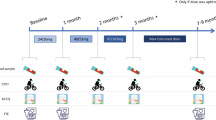Summary
The chronic effects of the oral administration of OPC-8212 (3,4-DIHYDRO-6-[4-(3,4-dimethoxybenzoyl)-1-piperazinyl]-2(1H)-quinolinone) on resting hemodynamics and exercise capacity were assessed in 15 patients with congestive heart failure (NYHA II–IV). Doses of 30 or 60 mg per day were given per os over 3.0 weeks on average (range 2–6 weeks). Multigated radionuclide ventriculography and multistage exercise testing were performed before and during OPC-8212 therapy to assess the changes in left ventricular volume and exercise capacity respectively. Systolic blood pressure showed a slight increase (from 123±3 to 129±4 mmHg) during OPC-8212 therapy, while heart rate was unchanged (69±3 vs 67±3 beats/min). The left ventricular end-diastolic volume index decreased from 127±9 to 107±7 ml/m2, and ejection fraction and the P/V index (the ratio of peak systolic pressure to left ventricular end-systolic volume index) increased during OPC-8212 therapy (from 27%±3% to 30%±4% and from 1.5±0.2 to 2.0±0.3 mmHg/ml/m2 respectively). NYHA functional class was improved in 9 of 15 patients, and the average peak work load achieved during exercise testing increased from 27±6 to 47±7 W. No significant adverse effect was observed in any patient. These results indicate that OPC-8212 enhances the inotropic state and, hence, reduces heart size with no change in heart rate. Moreover, it increases exercise capacity. Thus, OPC-8212 is an inotropic agent with promise for application in the long-term treatment of congestive heart failure.
Similar content being viewed by others
References
Ferrer MI, Conroy RJ, Harvey RM (1960) Some effects of digoxin upon the heart and circulation in man. Digoxin in combined left and right ventricular failure. Circulation 21: 372–385
Arnold SB, Byrd RC, Meister W, Melman K, Cheitlin MD, Brestow JD, Parmley WW, Chatterjee K (1980) Long-term digitalis therapy improves left ventricular function in heart failure. N Engl J Med 303: 1443–1448
McHaffie D, Purcell H, Mitchell-Heggs P, Guz A (1978) The clinical value of digoxin in patients with heart failure and sinus rhythm. Q J Med 47: 401–419
Beller GA, Smith TW, Abelmann WH, Haber E, Hood WB Jr (1971) Digitalis intoxication: prospective clinical study with serum level correlations. N Engl J Med 284: 989–997
Chatterjee K, Parmley WW (1977) The role of vasodilator therapy in heart failure. Prog Cardiovasc Dis 19: 301–325
Cohn JN, Franciosa JA (1977) Vasodilator therapy of cardiac failure. N Engl J Med 297: 27–31
Colucci WS, Williams GH, Alexander RW, Braunwald E (1981) Mechanisms and implications of vasodilator tolerance in the treatment of congestive heart failure. Am J Med 71: 89–99
Bourdillon PDV, Dawson JR, Foale RA, Timmis AD, Poole-Wilson PA, Sutton GC (1980) Salbutamol in treatment of heart failure. Br Heart J 43: 206–210
Sharma B, Hoback J, Francis GS, Hodges M, Asinger RW, Cohn JN, Taylor CR (1981) Pirbuterol: a new oral sympathomimetic amine for the treatment of congestive heart failure. Am Heart J 102: 533–541
Ward A, Brogden RN, Heel RC, Speight TM, Avery GS (1983) Amrinone. A preliminary review of its pharmacological properties and therapeutic use. Drugs 26: 468–502
Yamashita S, Hosokawa T, Kojima M, Mori T, Yabuuchi Y (1984) In vitro and in vivo studies of 3,4-dihydro-6-[4-(3,4-dimethoxybenzoyl)-1-piperazinyl]-2(1H)-quinolinone (OPC-8212), a novel positive inotropic drug, in various animals. Arzneim Forsch Drug Res 34(I): 342–346
Taira N, Endoh M, Iijima T, Satoh K, Yanagisawa T, Yamashita S, Maruyama M, Kawada M, Morita T, Wada Y (1984) Mode and mechanism of action of 3,4-dihydro-6-[4-(3,4-dimethoxybenzoyl)-1-piperazinyl]-2(1H)-quinolinone (OPC-8212), a novel positive inotropic drug, on the dog heart. Arzneim Forsch Drug Res 34(I): 347–355
Sasayama S, Inoue M, Asanoi H, Kodama K, Hori M, Sakurai T, Kawai C (1986) Acute hemodynamic effects of a new inotropic agent, OPC-8212, on severe congestive heart failure. Heart Vessels 2: 23–28
Miyamoto G, Sasabe H, Odomi M, Shimizu T (1985) High-performance liquid chromatographic procedure for the determination of a new positive inotropic agent, 3,4-dihydro-6-[4-(3,4-dimethoxybenzoyl)-1-piperazinyl]-2(1H)-quinolinone, in human plasma and urine. J Chromatogr 338: 450–455
Pavel DG, Zimmer AM, Patterson VN (1977) In vivo labeling of red blood cells with99mTc: a new approach to blood pool visualization. J Nucl Med 18: 305–308
Dehmer GJ, Lewis SE, Hillis LD, Twieg D, Falkoff M, Parkey RW, Willerson JT (1980) Nongeometric determination of left ventricular volumes from equilibrium blood pool scans. Am J Cardiol 45: 293–300
Chapman CB, Baker O, Reynolds J, Bonte FJ (1958) Use of biplane cine fluorography for measurement of ventricular volume. Circulation 18: 1105–1117
Suga H, Sagawa K, Shoukas AA (1973) Load independence of the instantaneous pressure-volume ratio of the canine left ventricle and effects of epinephrine and heart rate on the ratio. Circ Res 32: 314–322
Nivatpumin T, Katz S, Scheuer J (1979) Peak left ventricular systolic pressure/end-systolic volume ratio: a sensitive detector of left ventricular disease. Am J Cardiol 43: 969–974
El-Tobgi S, Fouad FM, Kramer JR, Rincon G, Sheldon WC, Tarazi RC (1984) Left ventricular function in coronary artery disease. Evaluation of slope of end-systolic pressure-volume line (Emax) and ratio of peak systolic pressure to end-systolic volume (P/Ves). J Am Coll Cardiol 3: 781–788
Inoue M, Hori M, Nakajima S, Kitakaze M, Fukunami M, Ishida Y, Abe H (1984) Effects of 3,4-dihydro-6-[4-(3,4-dimethoxybenzoyl)-1-piperazinyl]-2(1H)-quinolinone (OPC-8212), a new inotropic agent, on cardiotonic activity and coronary hemodynamics. Arzneim Forsch Drug Res 34(I): 355–359
Sonnenblick EH (1968) Correlation of myocardial ultrastructure and function. Circulation 38: 29–44
Author information
Authors and Affiliations
Rights and permissions
About this article
Cite this article
Inoue, M., Kim, BH., Hori, M. et al. Oral OPC-8212 for the treatment of congestive heart failure: Hemodynamic improvement and increased exercise capacity. Heart Vessels 2, 166–171 (1986). https://doi.org/10.1007/BF02128143
Issue Date:
DOI: https://doi.org/10.1007/BF02128143




